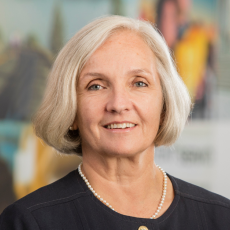You have extensive experience in the fight against cancer; tell us more about yourself and the role patient advocacy plays in the larger scope of healthcare in the United States.
I am a hematologist-oncologist and a molecular biologist by training, and I did research and patient care in academia for several years. I took care of patients with leukemia, lymphoma, myeloma and other blood cancers and I did patient translational research. Five years ago, I was recruited to The Leukemia & Lymphoma Society (LLS) and currently I oversee all the Mission programs (including research, policy and advocacy, and education and support). Blood cancers are a relatively rare group (10% to 20% of all cancers) and in the last ten years, 40% of the drug approvals have happened in this space. At LLS, we invested early in the right science and then in the clinical trials that led to larger pharma companies taking these assets and moving them forward. We are proud that our support has been key to advancing 75% of the blood cancer treatment approvals over the last five years.
People tend to pigeonhole nonprofit research groups, but The Leukemia & Lymphoma Society is the second largest cancer research organization in the U.S., and we also have a Canadian partner organization.

The organization was founded over 70 years ago by a family that lost their child to leukemia - which back then was a fatal disease. Now, thanks to the advancements achieved in treatments, that same child would have had a 90% chance of survival.
Where does LLS fit in this system where people lump patient advocacy groups into one category?
Unlike an organization that raises funds just for research, we are not unidimensional and we offer a multitude of services: funding for cancer research centers, financial aid for patients and therapy acceleration programs for small biopharma companies. Through our venture philanthropy Therapy Acceleration Program, we help biopharma and academia to work and move towards the blood cancer space. Given that we also support research, patients, and providers, we have built strong relationships with the FDA, the National Cancer Institute and all the big academic cancer centers and their researchers. We have 27 regional offices and an information resource center through which we help patients and caregivers who need support, including financial help or access to clinical trials. All these services are free to blood cancer patients and caregivers.
There is a perennial tension in the pharma space between companies making profit and patients having access to their medication - what is your view on that balance right now and how do you think the IRA might impact it?
Our patients are greatly impacted by the cost of new therapies. Other cancers have standard off-patent therapies and therefore are not garnering as big a profit margin so the cost is much lower. The greatest example is myeloma, which is a disease of middle and older age and many of the patients are Medicare age. Someone who lives on Medicare benefits makes $44,000 per year and the new medicines for myeloma may have an out-of-pocket cost of $16,000. The IRA offers a $2,000 out of pocket cap which will make a huge difference in affording the actual medicine. With the cap, patients can get the medicine they need and stay on it, which impacts their survival. The inflation reduction act can also have a positive outcome for pharma companies because patients will fill their prescriptions and, in the end, it is going to be a win-win from that point of view.
Having worked in the pharmaceutical industry I understand that innovation is critical but we have to find a way to avoid waste during clinical trials. We, as the research community, can help pharma by guiding more patients to participate in their trials so they can enroll faster and cost less. LLS is the sponsor of several master trials: one in adult leukemia (Beat AML®) and one for pediatric acute leukemia (PedAL). We work with multiple pharma partners in an international context and patients can choose between several options. These types of trials are cost efficient for pharma and more importantly are efficient for patients finding an appropriate clinical trial.
What are some of the challenges that you are bumping into when it comes to therapies and their access?
New therapies and how we provide access to them is one of the priorities of LLS. The major cancer centers are in big cities, but many people live hundreds of miles away or have a schedule that does not allow them to come for treatment. As a result, the majority of cancer care does not happen at big centers, but they are rather used for the innovation side. Access to innovative therapies is a big problem in the U.S. and it is magnified in other parts of the world.
We are currently sponsoring a research program called ‘Equity in Access’ and the goal is to look at access to care. The first group of research relates to insurance coverage and how insurance has an impact on access to therapy. Many cancer clinics buy up small practices and they become health networks, but they do not always transport the clinical trials out to the community doctors. Some of the community practitioners cannot support clinical trials because they are seeing too many patients per day, or they lack an infusion center. We need to make sure innovations go to fruition and pharma collaboration could be immensely helpful in this sense, especially by increasing access to trials. By coming up with innovative solutions to bring trials closer to home, they will increase the diversity of their clinical trials from a demographic point of view.





